Sea turtle catch rates
Sampling design evaluations
The sampling design of the regional trawl survey was established through a series of meetings and proposal reviews by a panel of sea turtle experts throughout 1999. Following delineation of the geographical boundaries of the survey, the next most critical issue was to determine how much sampling effort was required each year to reliably report trends. To answer this question, two independent analyses of incidental sea turtle catch rates in the SEAMAP-SA survey were initiated using (a) summer data between Winyah Bay, SC and St. Augustine, FL between 1995 and 1998 (160 trawling events) and (b) spring and summer data (78 trawling events) between Cape Hatteras, NC and Cape Canaveral, FL during 1997 and 1998. In both cases loggerhead and Kemp’s ridley sea turtles were not captured in 91–94% and 99–100% of trawling events.
Two different methods were used to estimate annual minimum sample size for these data sets. In the larger data set, a "tolerable error" [16] of 20% was used to determine that, based on the nearly negative binomial distribution of positive catches, 474 x 20 minute (316 x 30 min) trawling events were needed each year to reliably report loggerhead catch rates. In the smaller data set, the desired coefficient of variation (CV), a standardized measure of dispersion, was set to 0.2 and used to determine that 64 x 100' net-hours of trawling were needed annually.

The relationship between catch rate (y-axis) and annual sampling effort (x-axis) needed to report annual catch rates with confidence. As evident from the curved line, less annual sampling effort is needed to report high catch rates with confidence whereas confidence in lower catch rates requires greater sampling effort.
Given the headrope length of 60’ and two nets being towed, a 30 minute trawling event represents 0.6 standardized trawling hours; thus, 107 x 30 minute trawling events were needed. More annual trawling events (365 x 30 minutes) were estimated to be needed to reliably report trends for the proportion of loggerhead sea turtles presumed to have originated from beaches north of St. Augustine, FL and for infrequently caught Kemp’s ridley sea turtles (810 x 30 minutes), with the estimated sample size for these scenarios following a quadratic relationship. In the larger data set, 474 trawling events x 0.5 standardized hours were estimated to be needed to produce a reliable estimate of mean catch, which converts to 396 x 30 minute tows with 65’ headrope nets.
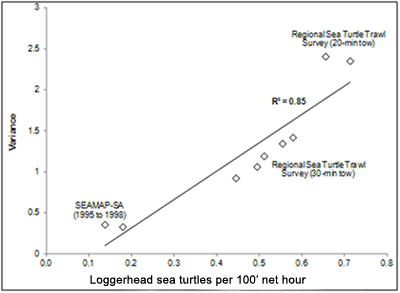
The increasing relationship between variance (y-axis) and catch rates (x-axis), which often precludes the ability to detect trends over time in data sets where positive catch events are infrequent.
During the first four years of the regional trawl survey, 172 to 250 loggerhead sea turtles, 10 to 19 Kemp’s ridley sea turtles, and 0 to 3 green sea turtles were captured annually. Significantly fewer events were associated with not capturing loggerheads (2017 of 2622, 77%), but capture rates for Kemp’s ridley sea turtles were comparable (2571 of 2622, 98%) to SEAMAP-SA data. Higher annual mean catch rates for loggerhead sea turtles in the regional sea turtle trawl survey were associated with increased variance but decreased CV; however, even improved CV's remained 10x greater than the desired 0.2 level.
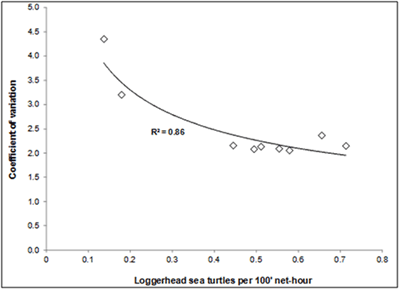
The declining relationship between the co-efficient of variation (y-axis) and catch rates (x-axis), which renders greater confidence in higher reported catch rates.
Because variance increases concurrent with mean catch rates due to (a) catching sea turtles more frequently and (b) occasionally catching multiple sea turtles at a time, and because CV is logarithmically related to mean catch rate, reducing CV to the desired 0.2 level may be unrealistic for in-water sea turtle surveys given that actual catches are skewed towards zeros and singles, with maximum catches <10 per tow. Nevertheless, these collective observations suggest that the regional sea turtle trawl survey represents a great improvement over the SEAMAP-SA data set with regards to the reliability for reporting inter-annual catch trends for sea turtles in coastal waters of the Southeast U.S.
Prior to resuming the regional sea turtle trawl survey in 2008, a boot-strapping exercise was also performed to determine the potential statistical impacts on reducing annual sampling effort in light of rising operational costs, stable to declining annual funding, and finite vessel sea days. During this exercise it was agreed that sampling effort could be reduced by 20% without detrimental impacts to the statistical validity of the survey, which was achieved by reducing the number of vessels participating in the annual survey from three to two. Two additional changes in the sampling design also resulted from this exercise in an effort to increase the number of trawling events conducted during each sea day: sub-sampling for small biota with a 15’ try-net during the trawl was discontinued and (b) SEAMAP-SA stations were pooled with regional sea turtle trawling stations to reduce transit distance between successive trawling locations.
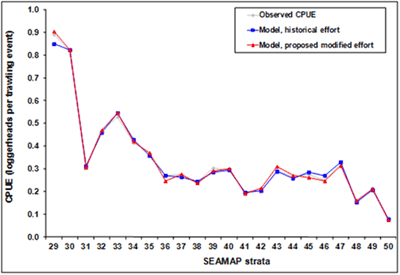
A comparison of actual catch rates and modeled (200 bootstrap iterations) catch rates based on a 20% reduction in annual sampling effort. This exercise was used to determine that the annual sampling effort of approximately 650 trawling events could be reduced by 20% without adversely affecting the quality of the data collected.
Despite a reduction in the occurrence of zero turtle capture events in the regional sea turtle trawl survey relative to the SEAMAP-SA data set, the high frequency (>70%) of zero turtle capture events has remained controversial, particularly with regards to methods used for data analysis. In response to concerns that frequent non turtle capture represents an inherent sampling flaw, we counter that non capture events plague most marine surveys where the spatial distributions of animals are often patchy [17]. This assertion was substantiated by two distinct efforts to evaluate modified sampling designs to determine what, if any, improvements would result in capture and recapture frequencies.
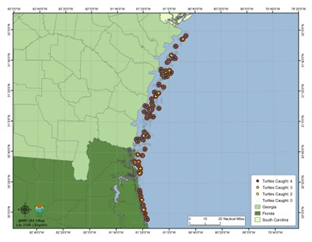 Targeted trawling in the general vicinity of "hot spots" in August 2008 increased catch rates for loggerhead sea turtles (38 loggerhead sea turtles in 27 x 20 minute tows) and reduced the frequency of non capture events off Florida and Georgia (13 of 27 events, 48%), but made no difference for similar efforts expended off South Carolina (6 loggerhead sea turtles 42 events; no loggerhead sea turtles captured in 37 of 42 events, 88%).
Targeted trawling in the general vicinity of "hot spots" in August 2008 increased catch rates for loggerhead sea turtles (38 loggerhead sea turtles in 27 x 20 minute tows) and reduced the frequency of non capture events off Florida and Georgia (13 of 27 events, 48%), but made no difference for similar efforts expended off South Carolina (6 loggerhead sea turtles 42 events; no loggerhead sea turtles captured in 37 of 42 events, 88%).
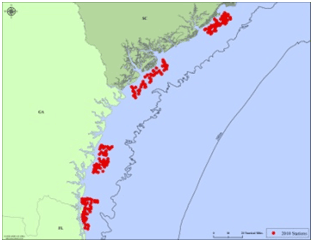 Between May and July 2010, trawling effort was focused and repeatedly conducted in four small-scale areas within the regional sea turtle trawl survey boundaries. Non-capture frequency (295 of 410 events, 72%) was similar to previous years, and repeat trawling did not dramatically increase recapture rates for sea turtles tagged in the study within or among sampling seasons [18].
Between May and July 2010, trawling effort was focused and repeatedly conducted in four small-scale areas within the regional sea turtle trawl survey boundaries. Non-capture frequency (295 of 410 events, 72%) was similar to previous years, and repeat trawling did not dramatically increase recapture rates for sea turtles tagged in the study within or among sampling seasons [18].
Following approximately six months of evaluating various advanced statistical models and fitting the trawl survey data to various distributions, catch data are now fit to a negative binomial distribution and analyzed using a Generalized Linear Model (GLM) with log-link function. Sampling effort is treated as an offset term due to reduced tow times (from 30 to 20 minutes) associated with sampling in 2008 and 2009 under a previous federal permit. Loggerhead sea turtle captures per trawling event have been analyzed with respect to a 100’ net-hour for data collected in the Charleston, SC shipping channel [13] and with respect to linear trawl length for the regional sea turtle trawl survey [15]. Analysis of catch rates for Kemp’s ridley sea turtles in the regional sea turtle trawl survey have also been completed, and we anticipate publication of data collected through 2012 in 2013.
Future study evaluation interests include the use of net mensuration gear to monitor trawl net performance (i.e., vertical and horizontal net spread) under a variety of sampling conditions to determine if gear performance is constant or if correction factors should be built into the GLM. Similarly, we hope to use advanced sonar technology to generate catch-independent data sets regarding the retention vs. escapement of sea turtles that encounter the trawl gear.
16 Elliott, J.M. 1977. Some Methods for the Statistical Analysis of Samples of Benthic Invertebrates, 2nd ed., Sci. Publ. No. 25, Freshwater Biological Association, Ferry House, U.K., 156p.
17 Pennington, M. 1996. Estimating the mean and variance from highly skewed marine data. Fishery Bulletin 94(3):498–505
18 Arendt, M.D., J.A. Schwenter, J.I. Byrd, J.D. Whitaker, L. Liguori, L. Parker, and D.W. Owens. 2010. Relative abundance, distribution, and health of sea turtles in near-shore coastal waters of the Southeastern United States. Annual report to the National Marine Fisheries Service for Award NA08NMF4720502, 43p.
